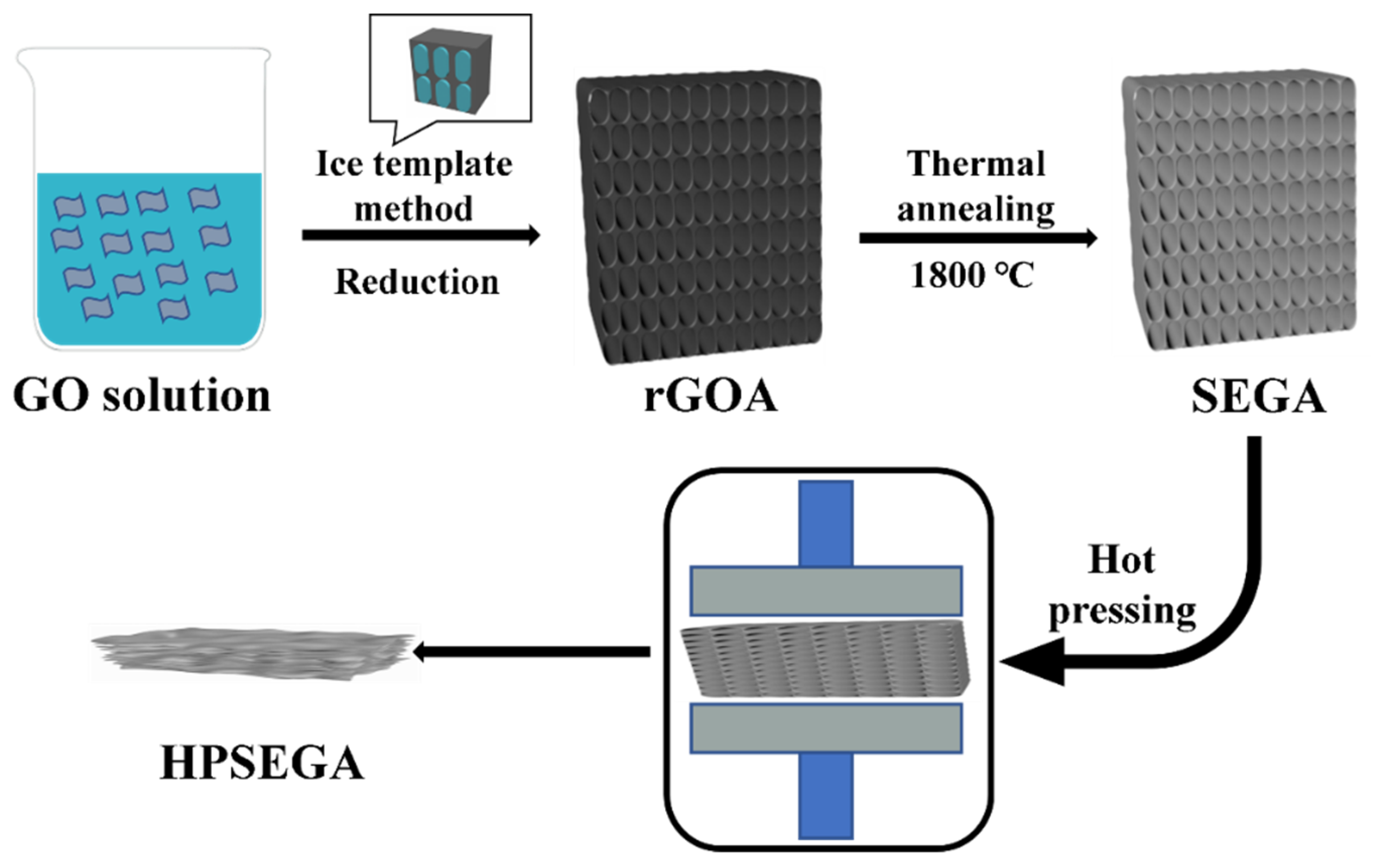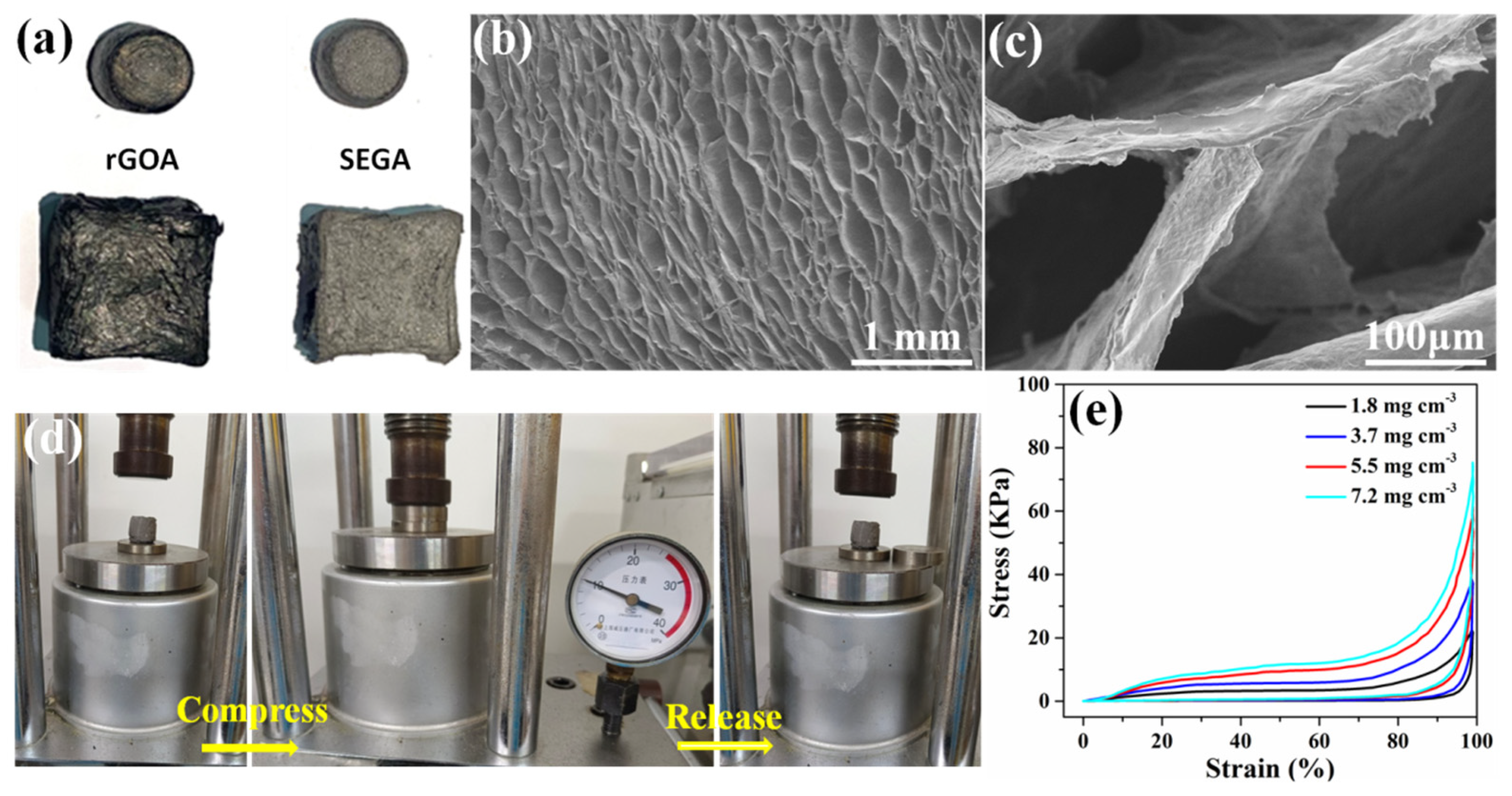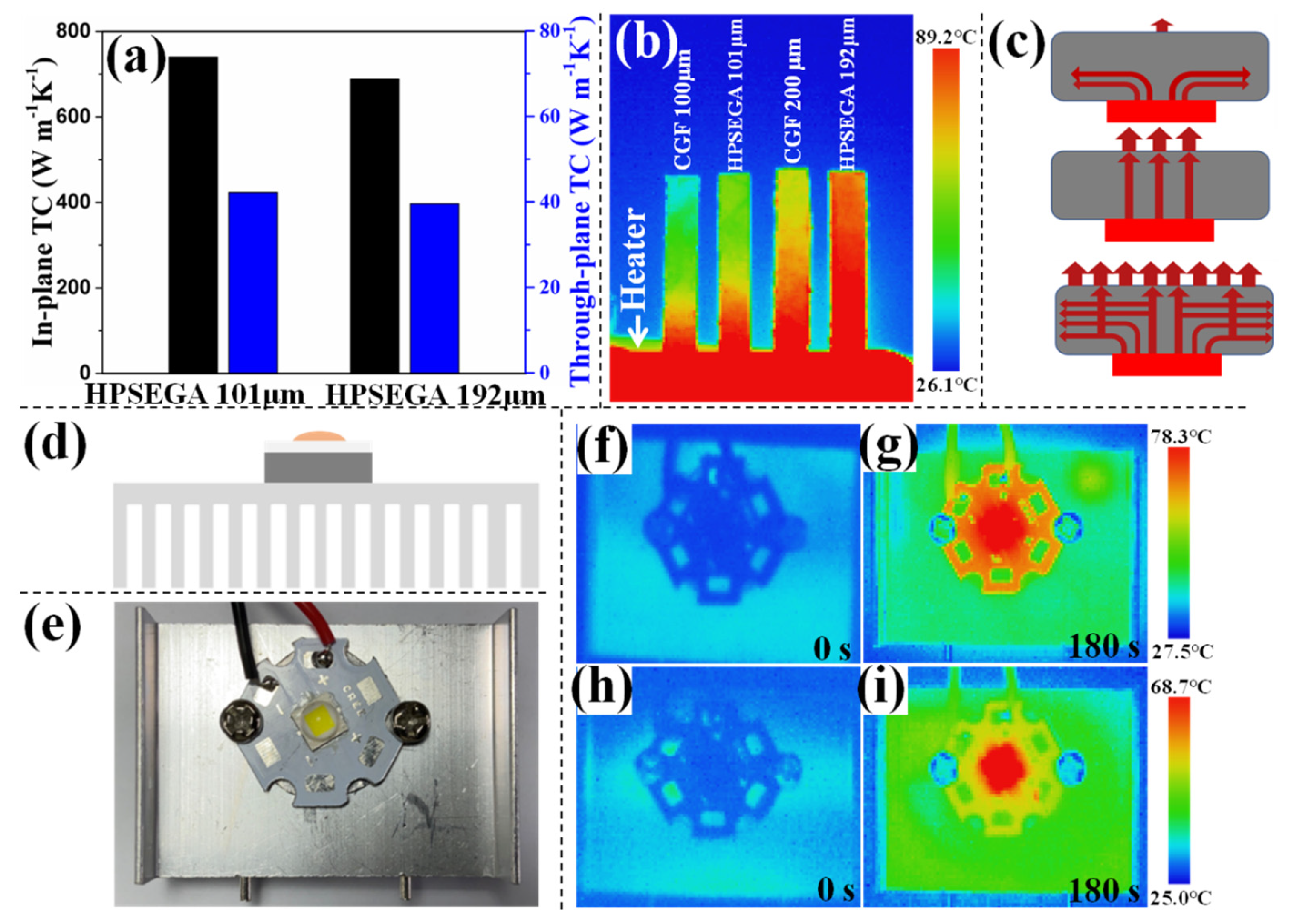Hot-Pressed Super-Elastic Graphene Aerogel with Bidirectional Thermal Conduction Properties as Thermal Interface Materials
Abstract
:1. Introduction
| Highly Thermal-Conductive Graphene-Based Films | In-Plane TC (W m−1 K−1) | Through-Plane TC (W m−1 K−1) | Thickness (μm) | Density (g cm−3) |
|---|---|---|---|---|
| High TC in single direction | ||||
| Graphene paper [10] | 1434 | - | - | 2.1 |
| Graphene-based hybrid film [11] | 1597 | 2.65 | 7 | - |
| GF [35] | 1940 | - | 10 | 2.03 |
| GF [36] | 1043.5 | - | - | - |
| Ultra-thin GF [37] | 3200 | - | 0.8 | 2.1 |
| GF [38] | 1100 | - | 8.1 | |
| Large-sized GF [39] | 803.1 | 3.98 | 14 | 2.05 |
| Ball-milling exfoliated graphene paper [40] | 1529 | - | 30 | 1.8 |
| Glucose-modified GF [41] | 1300 | - | - | - |
| Electrochemically exfoliated graphene paper [42] | 1022.8 | - | - | - |
| Bidirectional high TC | ||||
| Vertical carbon nanotube@SiC-graphene film [17] | 397.9 | 41.7 | 200 | - |
| Graphene/nanocopper film [27] | 234.9 | 5.22 | - | - |
| Graphene-SiO2@C film [29] | 36.54 | 6.65 | - | - |
| Graphene–carbon nanotube [30] | 933.37 | 6.27 | 106 | 0.985 |
| Graphene–carbon nanotube–graphite film [31] | 182.6 | 32.96 | 6000 | 1.67 |
| Graphene hybrid paper [33] | 263 | 17.6 | 500 | 0.8 |
| Carbon nanoring/graphene hybrid paper [34] | 890 | 5.81 | - | - |
| This work | 740.3 | 42.5 | 101 | 1.35 |
| 688.1 | 39.6 | 192 | 1.57 | |
2. Materials and Methods
2.1. Preparation of HPSEGA Film
2.2. Characterization
3. Results and Discussion
4. Conclusions
Supplementary Materials
Author Contributions
Funding
Institutional Review Board Statement
Informed Consent Statement
Data Availability Statement
Conflicts of Interest
References
- Khan, J.; Momin, S.A.; Mariatti, M. A Review on Advanced Carbon-Based Thermal Interface Materials for Electronic Devices. Carbon 2020, 168, 65–112. [Google Scholar] [CrossRef]
- Zhang, F.; Feng, Y.; Feng, W. Three-Dimensional Interconnected Networks for Thermally Conductive Polymer Composites: Design, Preparation, Properties, and Mechanisms. Mater. Sci. Eng. R Rep. 2020, 142, 100580. [Google Scholar] [CrossRef]
- Sudhindra, S.; Kargar, F.; Balandin, A.A. Noncured Graphene Thermal Interface Materials for High-Power Electronics: Minimizing the Thermal Contact Resistance. Nanomaterials 2021, 11, 1699. [Google Scholar] [CrossRef] [PubMed]
- Der, O.; Edwardson, S.; Marengo, M.; Bertola, V. Engineered Composite Polymer Sheets with Enhanced Thermal Conductivity. IOP Conf. Ser. Mater. Sci. Eng. 2019, 613, 012008. [Google Scholar] [CrossRef]
- Nikolayev, V.S. Physical Principles and State-of-the-Art of Modeling of the Pulsating Heat Pipe: A Review. Appl. Therm. Eng. 2021, 195, 117111. [Google Scholar] [CrossRef]
- Lv, L.; Dai, W.; Yu, J.; Jiang, N.; Lin, C.T. A Mini Review: Application of Graphene Paper in Thermal Interface Materials. New Carbon Mater. 2021, 36, 930–938. [Google Scholar] [CrossRef]
- Zhang, Y.; Heo, Y.J.; Son, Y.R.; In, I.; An, K.H.; Kim, B.J.; Park, S.J. Recent Advanced Thermal Interfacial Materials: A Review of Conducting Mechanisms and Parameters of Carbon Materials. Carbon 2019, 142, 445–460. [Google Scholar] [CrossRef]
- Feng, C.P.; Chen, L.B.; Tian, G.L.; Wan, S.S.; Bai, L.; Bao, R.Y.; Liu, Z.Y.; Yang, M.B.; Yang, W. Multifunctional Thermal Management Materials with Excellent Heat Dissipation and Generation Capability for Future Electronics. ACS Appl. Mater. Interfaces 2019, 11, 18739–18745. [Google Scholar] [CrossRef]
- Hou, Z.L.; Song, W.L.; Wang, P.; Meziani, M.J.; Kong, C.Y.; Anderson, A.; Maimaiti, H.; LeCroy, G.E.; Qian, H.; Sun, Y.P. Flexible Graphene–Graphene Composites of Superior Thermal and Electrical Transport Properties. ACS Appl. Mater. Interfaces 2014, 6, 15026–15032. [Google Scholar] [CrossRef]
- Xin, G.; Sun, H.; Hu, T.; Fard, H.R.; Sun, X.; Koratkar, N.; Borca-Tasciuc, T.; Lian, J. Large-Area Freestanding Graphene Paper for Superior Thermal Management. Adv. Mater. 2014, 26, 4521–4526. [Google Scholar] [CrossRef]
- Zou, R.; Liu, F.; Hu, N.; Ning, H.; Gong, Y.; Wang, S.; Huang, K.; Jiang, X.; Xu, C.; Fu, S.; et al. Graphene/Graphitized Polydopamine/Carbon Nanotube All-Carbon Ternary Composite Films with Improved Mechanical Properties and through-Plane Thermal Conductivity. ACS Appl. Mater. Interfaces 2020, 12, 57391–57400. [Google Scholar] [CrossRef] [PubMed]
- Yang, G.; Yi, H.; Yao, Y.; Li, C.; Li, Z. Thermally Conductive Graphene Films for Heat Dissipation. ACS Appl. Nano Mater. 2020, 3, 2149–2155. [Google Scholar] [CrossRef]
- Chen, S.; Wang, Q.; Zhang, M.; Huang, R.; Huang, Y.; Tang, J.; Liu, J. Scalable Production of Thick Graphene Film for Next Generation Thermal Management Application. Carbon 2020, 167, 270–277. [Google Scholar] [CrossRef]
- Malekpour, H.; Chang, K.H.; Chen, J.C.; Lu, C.Y.; Nika, D.L.; Novoselov, K.S.; Balandin, A.A. Thermal Conductivity of Graphene Laminate. Nano Lett. 2014, 14, 5155–5161. [Google Scholar] [CrossRef] [PubMed]
- Liu, L.; Bian, X.M.; Tang, J.; Xu, H.; Hou, Z.L.; Song, W.L. Exceptional Electrical and Thermal Transport Properties in Tunable All-Graphene Papers. RSC Adv. 2015, 5, 75239–75247. [Google Scholar] [CrossRef]
- Dai, W.; Ma, T.; Yan, Q.; Gao, J.; Tan, X.; Lv, L.; Hou, H.; Wei, Q.; Yu, J.; Wu, J.; et al. Metal-Level Thermally Conductive yet Soft Graphene Thermal Interface Materials. ACS Nano 2019, 13, 11561–11571. [Google Scholar] [CrossRef] [PubMed]
- Peng, L.; Yu, H.; Chen, C.; He, Q.; Zhang, H.; Zhao, F.; Qin, M.; Feng, Y.; Feng, W. Tailoring Dense, Orientation–Tunable, and Interleavedly Structured Carbon-Based Heat Dissipation Plates. Adv. Sci. 2023, 10, 2205962. [Google Scholar] [CrossRef]
- Li, Y.; Zhu, Y.; Jiang, G.; Cano, Z.P.; Yang, J.; Wang, J.; Liu, J.; Chen, X.; Chen, Z. Boosting the Heat Dissipation Performance of Graphene/Polyimide Flexible Carbon Film Via Enhanced through-Plane Conductivity of 3d Hybridized Structure. Small 2020, 16, 1903315. [Google Scholar] [CrossRef]
- Zhou, Y.; Wu, S.; Long, Y.; Zhu, P.; Wu, F.; Liu, F.; Murugadoss, V.; Winchester, W.; Nautiyal, A.; Wang, Z.; et al. Recent Advances in Thermal Interface Materials. ES Mater. Manuf. 2020, 7, 4–24. [Google Scholar] [CrossRef]
- Xu, S.; Wang, S.; Chen, Z.; Sun, Y.; Gao, Z.; Zhang, H.; Zhang, J. Electric-Field-Assisted Growth of Vertical Graphene Arrays and the Application in Thermal Interface Materials. Adv. Funct. Mater. 2020, 30, 2003302. [Google Scholar] [CrossRef]
- Ci, H.; Chang, H.; Wang, R.; Wei, T.; Wang, Y.; Chen, Z.; Sun, Y.; Dou, Z.; Liu, Z.; Li, J.; et al. Enhancement of Heat Dissipation in Ultraviolet Light-Emitting Diodes by a Vertically Oriented Graphene Nanowall Buffer Layer. Adv. Mater. 2019, 31, 1901624. [Google Scholar] [CrossRef] [PubMed]
- Lian, G.; Tuan, C.C.; Li, L.; Jiao, S.; Wang, Q.; Moon, K.S.; Cui, D.; Wong, C.P. Vertically Aligned and Interconnected Graphene Networks for High Thermal Conductivity of Epoxy Composites with Ultralow Loading. Chem. Mater. 2016, 28, 6096–6104. [Google Scholar] [CrossRef]
- An, F.; Li, X.; Min, P.; Liu, P.; Jiang, Z.G.; Yu, Z.Z. Vertically Aligned High-Quality Graphene Foams for Anisotropically Conductive Polymer Composites with Ultrahigh through-Plane Thermal Conductivities. ACS Appl. Mater. Interfaces 2018, 10, 17383–17392. [Google Scholar] [CrossRef] [PubMed]
- Li, X.H.; Liu, P.; Li, X.; An, F.; Min, P.; Liao, K.N.; Yu, Z.Z. Vertically Aligned, Ultralight and Highly Compressive All-Graphitized Graphene Aerogels for Highly Thermally Conductive Polymer Composites. Carbon 2018, 140, 624–633. [Google Scholar] [CrossRef]
- Zhang, Y.F.; Han, D.; Zhao, Y.H.; Bai, S.L. High-Performance Thermal Interface Materials Consisting of Vertically Aligned Graphene Film and Polymer. Carbon 2016, 109, 552–557. [Google Scholar] [CrossRef]
- Xu, S.; Zhang, J. Vertically Aligned Graphene for Thermal Interface Materials. Small Strut. 2020, 1, 2000034. [Google Scholar] [CrossRef]
- Sun, P.; Liu, B.; You, Z.; Zheng, Y.; Wang, Z. Graphene/Copper Nanoparticles as Thermal Interface Materials. ACS Appl. Nano Mater. 2022, 5, 3450–3457. [Google Scholar] [CrossRef]
- Xiang, J.; Drzal, L.T. Electron and Phonon Transport in Au Nanoparticle Decorated Graphene Nanoplatelet Nanostructured Paper. ACS Appl. Mater. Interfaces 2011, 3, 1325–1332. [Google Scholar] [CrossRef]
- Yu, Y.; Zhao, Y.; Zhang, X.; Wang, L.; Liao, B.; Pang, H. Construction of a 3d Thermal Transport Hybrid Via the Creation of Axial Thermal Conductive Pathways between Graphene Layers. Mater. Lett. 2022, 307, 130949. [Google Scholar] [CrossRef]
- Jia, H.; Kong, Q.Q.; Yang, X.; Xie, L.J.; Sun, G.H.; Liang, L.L.; Chen, J.P.; Liu, D.; Guo, Q.G.; Chen, C.M. Dual-Functional Graphene/Carbon Nanotubes Thick Film: Bidirectional Thermal Dissipation and Electromagnetic Shielding. Carbon 2021, 171, 329–340. [Google Scholar] [CrossRef]
- Lv, F.; Qin, M.; Zhang, F.; Yu, H.; Gao, L.; Lv, P.; Wei, W.; Feng, Y.; Feng, W. High Cross-Plane Thermally Conductive Hierarchical Composite Using Graphene-Coated Vertically Aligned Carbon Nanotubes/Graphite. Carbon 2019, 149, 281–289. [Google Scholar] [CrossRef]
- Feng, W.; Qin, M.; Lv, P.; Li, J.; Feng, Y. A Three-Dimensional Nanostructure of Graphite Intercalated by Carbon Nanotubes with High Cross-Plane Thermal Conductivity and Bending Strength. Carbon 2014, 77, 1054–1064. [Google Scholar] [CrossRef]
- Dai, W.; Lv, L.; Lu, J.; Hou, H.; Yan, Q.; Alam, F.E.; Li, Y.; Zeng, X.; Yu, J.; Wei, Q.; et al. A Paper-Like Inorganic Thermal Interface Material Composed of Hierarchically Structured Graphene/Silicon Carbide Nanorods. ACS Nano 2019, 13, 1547–1554. [Google Scholar] [CrossRef] [PubMed]
- Zhang, J.; Shi, G.; Jiang, C.; Ju, S.; Jiang, D. 3d Bridged Carbon Nanoring/Graphene Hybrid Paper as a High-Performance Lateral Heat Spreader. Small 2015, 11, 6197–6204. [Google Scholar] [CrossRef] [PubMed]
- Peng, L.; Xu, Z.; Liu, Z.; Guo, Y.; Li, P.; Gao, C. Ultrahigh Thermal Conductive yet Superflexible Graphene Films. Adv. Mater. 2017, 29, 1700589. [Google Scholar] [CrossRef] [PubMed]
- Song, N.J.; Chen, C.M.; Lu, C.; Liu, Z.; Kong, Q.Q.; Cai, R. Thermally Reduced Graphene Oxide Films as Flexible Lateral Heat Spreaders. J. Mater. Chem. A 2014, 2, 16563–16568. [Google Scholar] [CrossRef]
- Wang, N.; Samani, M.K.; Li, H.; Dong, L.; Zhang, Z.; Su, P.; Chen, S.; Chen, J.; Huang, S.; Yuan, G.; et al. Tailoring the Thermal and Mechanical Properties of Graphene Film by Structural Engineering. Small 2018, 14, 1801346. [Google Scholar] [CrossRef]
- Shen, B.; Zhai, W.; Zheng, W. Ultrathin Flexible Graphene Film: An Excellent Thermal Conducting Material with Efficient Emi Shielding. Adv. Funct. Mater. 2014, 24, 4542–4548. [Google Scholar] [CrossRef]
- Lin, S.; Ju, S.; Zhang, J.; Shi, G.; He, Y.; Jiang, D. Ultrathin Flexible Graphene Films with High Thermal Conductivity and Excellent Emi Shielding Performance Using Large-Sized Graphene Oxide Flakes. RSC Adv. 2019, 9, 1419–1427. [Google Scholar] [CrossRef]
- Teng, C.; Xie, D.; Wang, J.; Yang, Z.; Ren, G.; Zhu, Y. Ultrahigh Conductive Graphene Paper Based on Ball-Milling Exfoliated Graphene. Adv. Funct. Mater. 2017, 27, 1700240. [Google Scholar] [CrossRef]
- Li, J.; Chen, X.Y.; Lei, R.B.; Lai, J.F.; Ma, T.M.; Li, Y. Highly Thermally Conductive Graphene Film Produced Using Glucose under Low-Temperature Thermal Annealing. J. Mater. Sci. 2019, 54, 7553–7562. [Google Scholar] [CrossRef]
- Kwon, Y.J.; Kwon, Y.; Park, H.S.; Lee, J.U. Mass-Produced Electrochemically Exfoliated Graphene for Ultrahigh Thermally Conductive Paper Using a Multimetal Electrode System. Adv. Mater. Interfaces 2019, 6, 1900095. [Google Scholar] [CrossRef]
- Zhang, X.; Guo, Y.; Liu, Y.; Li, Z.; Fang, W.; Peng, L.; Zhou, J.; Xu, Z.; Gao, C. Ultrathick and Highly Thermally Conductive Graphene Films by Self-Fusion. Carbon 2020, 167, 249–255. [Google Scholar] [CrossRef]
- Nandihalli, N.; Mori, T.; Kleinke, H. Effect of Addition of SiC and Al2O3 Refractories on Kapitza Resistance of Antimonide-Telluride. AIP Adv. 2018, 8, 095009. [Google Scholar] [CrossRef]
- Chen, X.; Deng, X.; Kim, N.Y.; Wang, Y.; Huang, Y.; Peng, L.; Huang, M.; Zhang, X.; Chen, X.; Luo, D.; et al. Graphitization of Graphene Oxide Films under Pressure. Carbon 2018, 132, 294–303. [Google Scholar] [CrossRef]
- Nandihalli, N. A Short Account of Thermoelectric Film Characterization Techniques. Mater. Today Phys. 2023, 36, 101173. [Google Scholar] [CrossRef]
- Chen, X.; Dai, W.; Wu, T.; Luo, W.; Yang, J.; Jiang, W.; Wang, L. Thin Film Thermoelectric Materials: Classification, Characterization, and Potential for Wearable Applications. Coatings 2018, 8, 244. [Google Scholar] [CrossRef]
- Rozada, R.; Paredes, J.I.; Villar-Rodil, S.; Martínez-Alonso, A.; Tascón, J.M.D. Towards full repair of defects in reduced graphene oxide films by two-step graphitization. Nano Res. 2013, 6, 216–233. [Google Scholar] [CrossRef]





Disclaimer/Publisher’s Note: The statements, opinions and data contained in all publications are solely those of the individual author(s) and contributor(s) and not of MDPI and/or the editor(s). MDPI and/or the editor(s) disclaim responsibility for any injury to people or property resulting from any ideas, methods, instructions or products referred to in the content. |
© 2023 by the authors. Licensee MDPI, Basel, Switzerland. This article is an open access article distributed under the terms and conditions of the Creative Commons Attribution (CC BY) license (https://creativecommons.org/licenses/by/4.0/).
Share and Cite
Lv, P.; Zhou, X.; Chen, S. Hot-Pressed Super-Elastic Graphene Aerogel with Bidirectional Thermal Conduction Properties as Thermal Interface Materials. Materials 2023, 16, 7419. https://doi.org/10.3390/ma16237419
Lv P, Zhou X, Chen S. Hot-Pressed Super-Elastic Graphene Aerogel with Bidirectional Thermal Conduction Properties as Thermal Interface Materials. Materials. 2023; 16(23):7419. https://doi.org/10.3390/ma16237419
Chicago/Turabian StyleLv, Peng, Xiaofeng Zhou, and Songyue Chen. 2023. "Hot-Pressed Super-Elastic Graphene Aerogel with Bidirectional Thermal Conduction Properties as Thermal Interface Materials" Materials 16, no. 23: 7419. https://doi.org/10.3390/ma16237419
APA StyleLv, P., Zhou, X., & Chen, S. (2023). Hot-Pressed Super-Elastic Graphene Aerogel with Bidirectional Thermal Conduction Properties as Thermal Interface Materials. Materials, 16(23), 7419. https://doi.org/10.3390/ma16237419






